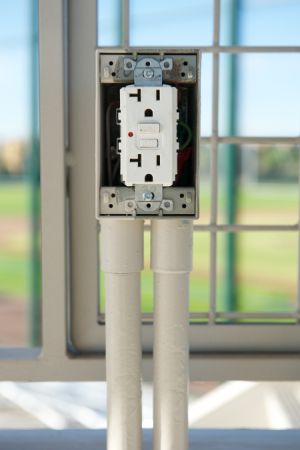Common Causes of GFCI Outlet Tripping

GFCI outlets, or Ground Fault Circuit Interrupter outlets, are an essential safety feature in modern homes. They are designed to protect you from electrical shocks by quickly shutting off the power when they detect a ground fault or short circuit. However, it can be frustrating when your GFCI outlet keeps tripping, especially if you don't know the cause. In this article, we'll explore the common causes of GFCI outlet tripping and how to troubleshoot and fix the issue or have a local Longmont electrician help.
What is a GFCI Outlet?
Before we dive into the causes of GFCI outlet tripping, let's first understand what a GFCI outlet is and how it works.
A GFCI outlet is a type of electrical outlet that has a built-in circuit breaker. It constantly monitors the flow of electricity through the circuit and can detect even the slightest imbalance in the current. If it detects a ground fault or short circuit, it will quickly shut off the power to prevent electrical shocks.
GFCI outlets are typically installed in areas where there is a higher risk of electrical shock, such as bathrooms, kitchens, and outdoor areas. They are easily recognizable by their "test" and "reset" buttons on the face of the outlet.
Common Causes of GFCI Outlet Tripping
Overloaded Circuit
One of the most common causes of GFCI outlet tripping is an overloaded circuit. This happens when there are too many appliances or devices plugged into the same circuit, causing it to draw more power than it can handle. This can also happen if you are using high-wattage appliances, such as hair dryers or space heaters, on the same circuit.
To fix this issue, try unplugging some devices from the circuit and see if the GFCI outlet stops tripping. If it does, you may need to redistribute your appliances and devices to different circuits or consider upgrading your electrical panel to handle the load.
Ground Fault or Short Circuit
A ground fault or short circuit is when electricity flows through an unintended path, such as through water or a person's body. This can happen if there is a damaged wire or faulty appliance in the circuit. When a GFCI outlet detects a ground fault or short circuit, it will immediately shut off the power to prevent electrical shocks.
To troubleshoot this issue, unplug all devices from the GFCI outlet and press the "reset" button. If the outlet stays on, then one of the devices you unplugged was causing the issue. You can then plug them back in one by one to determine which one is faulty. If the outlet continues to trip, there may be a damaged wire in the circuit, and you should call a licensed service electrician in Longmont to inspect and repair it.
Moisture or Water Damage
GFCI outlets are commonly installed in areas where there is a higher risk of moisture, such as bathrooms and kitchens. If water or moisture gets into the outlet, it can cause a ground fault and trip the outlet. This can also happen if the outlet is installed in an outdoor area and is exposed to rain or snow.
To fix this issue, make sure to keep the outlet dry and avoid using it if it is wet. You can also install a weatherproof cover for outdoor outlets to protect them from the elements.
Faulty GFCI Outlet
Sometimes, the GFCI outlet itself may be faulty and need to be replaced. Over time, these outlets can wear out and become less sensitive to ground faults, causing them to trip more frequently. If you have tried all the troubleshooting steps and the outlet continues to trip, it may be time to replace it.
How to Reset a GFCI Outlet
If your GFCI outlet has tripped, you can easily reset it by following these steps:
- Unplug all devices from the outlet.
- Press the "reset" button on the outlet.
- Plug in one device at a time to determine which one is causing the issue.
- If the outlet continues to trip, call a licensed professional electrician on call near me to inspect and repair the issue.
How to Prevent GFCI Outlet Tripping
While GFCI outlets are designed to protect you from electrical shocks, frequent tripping can be a nuisance. Here are some tips to prevent GFCI outlet tripping:
Avoid Overloading Circuits
As mentioned earlier, overloading a circuit is a common cause of GFCI outlet tripping. To prevent this, make sure to distribute your appliances and devices evenly across different circuits. You can also consider upgrading your electrical panel to handle more load.
Keep Outlets Dry
To prevent moisture or water damage, make sure to keep your GFCI outlets dry. If you have an outdoor outlet, consider installing a weatherproof cover to protect it from the elements.
Regular Maintenance
Regular maintenance of your electrical system can help prevent GFCI outlet tripping. Make sure to inspect your outlets for any signs of damage or wear and tear. If you notice any issues, call a licensed local electrician service to repair them.
When to Call a Licensed Electrician In Northern Colorado For Electrical Services
While some GFCI outlet tripping issues can be easily fixed, others may require the expertise of a licensed Longmont electrician. Here are some signs that you should call a professional:
- The outlet continues to trip even after unplugging all devices.
- You notice signs of damage or wear and tear on the outlet.
- Electrical problems persist.
- You are not comfortable troubleshooting or repairing electrical issues yourself.
Conclusion
GFCI outlets are an essential safety feature in modern homes, but they can be a nuisance when they keep tripping. By understanding the common causes of GFCI outlet tripping and following the tips in this article, you can prevent and troubleshoot these issues. Remember, if you are not comfortable working with electricity, always call an electrician in Longmont, CO, to inspect and help with any electrical repair any issues.
